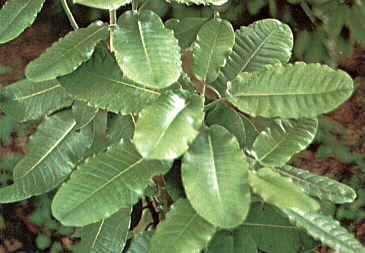QBARS - v27n1 Rhododendron hemsleyanum
Rhododendron hemsleyanum
David W. Goheen, Camas, Washington

|
|---|
R. hemsleyanum Photo by Dave Goheen |
In recent years, almost all rhododendron enthusiasts have become avid species collectors. Despite this trend, many very interesting and desirable species are either completely unknown in cultivation or are only rarely seen. The establishment of any of the lesser known varieties in collectors knowledge and esteem happens very slowly and years may pass before the plants become familiar garden subjects.
Such appears to be the case for R. hemsleyanum . I have been working with this distinctively foliaged plant of the Fortunei Series for about ten years, and it is only now becoming something more than a very obscure and little know species. I think its attributes are best summed up by reference to the words that E. H. M. Cox used when he first saw it growing at the Crystal Springs Rhododendron Garden in Portland, Oregon. Mr. Cox walked around the small tree exclaiming, "what a magnificent plant - what a magnificent plant."
This species, which evoked such an enthusiastic response from Mr. Cox is still, unfortunately, somewhat of a rarity and has only recently been receiving any attention from hybridizers. As late as the 1963 RHS species handbook, it was listed as being unknown in Western gardens. This was, however, corrected in the 1967 edition where it is reported as being in cultivation in the USA.
Its history for us dates back, apparently, to E. H. Wilson who collected and described it but did not get it established in garden culture. It was named in honor of the English botanist Hemsley, who was a friend of Mr. Wilson. The history of the species in the United States dates back to the period when Professor Hu was collecting in Western China. According to records at the University of Washington Arboretum in Seattle, the seeds from which the plants in the United States originated were collected by Hu in the area of Mount Omei in China's Szechwan province and were listed under his number 8823. The seeds were delivered to the Arnold Arboretum and from there were sent to Seattle where they were germinated. Several specimens were retained and others were sent to the gardens in Portland and San Francisco.
Two plants were grown in the Crystal Springs garden in Portland, and I believe the first plant to flower in the USA did so there in 1963. Since then, it has flowered elsewhere, notably in the arboretum in Seattle and seeds have been obtained from several selfings and cross fertilizations of specimen plants. Many second generation seedlings are now being grown in various places including Mr. Cox's garden in Scotland. so it is slowly becoming more widespread in its distribution. A few of the seedlings have reached flowering size.
R. hemsleyanum grows to form a vigorous large bush or small tree with rather thick glabrous branches. I do not know what its maximum size in the native state might be but the specimens in Portland, which are some 20 years old, are both over ten feet tall and as much wide. There appears to be some variation in habit and one plant is rather open while the other forms a more or less closely rounded large bush. Most of the seedlings I have grown tend to the open tree-like form.
Undoubtedly, its most notable characteristic is its magnificent foliage. The leaves are large and have a typically undulate margin. This has shown up in all of the seedlings I have seen. The leaves may be 10 inches or more in length and 5 inches or more in breadth and almost always are deeply auricled at the base. All in all, I feel it has the best foliage of the species in the Fortunei Series. R. calophytum is often grown in cooler climates to get big-leaved effects where R. grande and fictolacteum plants do not do well. I think that R. hemsleyanum could be considered for this niche. Certainly, its dark green, prominently veined leaves make a striking effect. I recommend it for any garden on the West Coast and believe it could be tried as far north as Philadelphia in the East.
Even though the plant flowers very late in the season - about July 1 in Portland - the buds may be somewhat tender and may be blasted by prolonged cold and dry winds in the winter. Except for this, on occasion, there has been no evidence of any other damage to the plants by any winter in Portland over the last 20 years.
The flower buds are characteristically quite long and pointed and are very glandular. The buds open to give ten or more rather large white, seven-lobed, fragrant flowers borne on a thick rachis. I have measured individual florets which were between 4 and 5 inches across.
A great deal of interest is now being shown in the use of this species as a hybrid parent. For several years, Merle Cisney and I made crosses between it and a large number of other species and various hybrids. The most important result of these crosses to date has been the observation that the offspring have all retained, at least in part, the interesting foliage traits of R. hemsleyanum . The cross with the hybrid, 'Indiana', resulted in plants with particularly good leaves. Only a limited number of the hybrids have bloomed. One plant of the cross with 'Autumn Gold' has bloomed vigorously and has showy, rather yellow flowers. Perhaps future blooms of this cross will be even better.
Many other crosses such as those with R. diaprepes , discolor , williamsianum , griersonianum , yakushimanum , 'Marcia' and 'Lodauric' are budded and should bloom next season. I look forward, hopefully, to finding blooms of real garden merit to complement the distinctive foliage that these hybrids have inherited from R. hemsleyanum .

